
Bohdan Zynoviy Mykhailovych Khmelnytsky was a Ruthenian nobleman and military commander of Zaporozhian Cossacks as Hetman of the Zaporozhian Host, which was then under the suzerainty of the Polish–Lithuanian Commonwealth. He led an uprising against the Commonwealth and its magnates (1648–1654) that resulted in the creation of an independent Cossack state in Ukraine. In 1654, he concluded the Treaty of Pereiaslav with the Russian Tsar and allied the Cossack Hetmanate with Tsardom of Russia, thus placing central Ukraine under Russian protection. During the uprising the Cossacks led a massacre of thousands of Poles and Jews during 1648–1649, making it one of the most traumatic events in the history of the Jews and antisemitism in Ukraine.
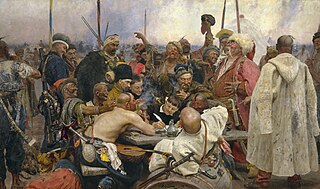
The Cossacks are a predominantly East Slavic Orthodox Christian people originating in the Pontic–Caspian steppe of eastern Ukraine and southern Russia. Historically, they were a semi-nomadic and semi-militarized people, who, while under the nominal suzerainty of various Eastern European states at the time, were allowed a great degree of self-governance in exchange for military service. Although numerous linguistic and religious groups came together to form the Cossacks, most of them coalesced and became East Slavic-speaking Orthodox Christians.

The Zaporozhian Cossacks, Zaporozhian Cossack Army, Zaporozhian Host, or simply Zaporozhians were Cossacks who lived beyond the Dnieper Rapids. Along with Registered Cossacks and Sloboda Cossacks, Zaporozhian Cossacks played an important role in the history of Ukraine and the ethnogenesis of Ukrainians.

Ivan Stepanovych Mazepa was a Ukrainian military, political, and civic leader who served as the Hetman of the Zaporizhian Host and the Left-bank Ukraine in 1687–1708. The historical events of Mazepa's life have inspired many literary, artistic and musical works. He was famous as a patron of the arts.

Left-bank Ukraine is a historic name of the part of Ukraine on the left (east) bank of the Dnieper River, comprising the modern-day oblasts of Chernihiv, Poltava and Sumy as well as the eastern parts of Kyiv and Cherkasy.

Kuban Cossacks, or Kubanians, are Cossacks who live in the Kuban region of Russia. Most of the Kuban Cossacks are descendants of different major groups of Cossacks who were re-settled to the western Northern Caucasus in the late 18th century. The western part of the region was settled by the Black Sea Cossack Host who were originally the Zaporozhian Cossacks of Ukraine, from 1792. The eastern and southeastern part of the host was previously administered by the Khopyour and Kuban regiments of the Caucasus Line Cossack Host and Don Cossacks, who were re-settled from the Don from 1777.

The Khmelnytsky Uprising, also known as the Cossack–Polish War, or the Khmelnytsky insurrection, was a Cossack rebellion that took place between 1648 and 1657 in the eastern territories of the Polish–Lithuanian Commonwealth, which led to the creation of a Cossack Hetmanate in Ukraine. Under the command of hetman Bohdan Khmelnytsky, the Zaporozhian Cossacks, allied with the Crimean Tatars and local Ukrainian peasantry, fought against Polish domination and the Commonwealth's forces. The insurgency was accompanied by mass atrocities committed by Cossacks against the civilian population, especially against the Roman Catholic and Ruthenian Uniate clergy and the Jews, as well as savage reprisals by Jeremi Wiśniowiecki, the voivode of the Ruthenian Voivodeship.
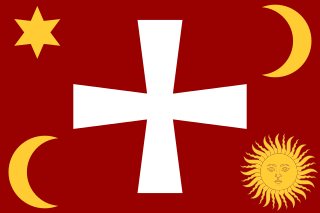
The Zaporozhian Sich was a semi-autonomous polity and proto-state of Cossacks that existed between the 16th to 18th centuries, including as an autonomous stratocratic state within the Cossack Hetmanate for over a hundred years, centred around the region now home to the Kakhovka Reservoir and spanning the lower Dnieper river in Ukraine. In different periods the area came under the sovereignty of the Polish–Lithuanian Commonwealth, the Ottoman Empire, the Tsardom of Russia, and the Russian Empire.
Rada is the term for "parliament" or "assembly" or some other "council" in several Slavic languages. Normally it is translated as "council". Sometimes it corresponds to "parliament", or in Soviet Union contexts, to "soviet". It also carries a meaning of advice, as in the English word "counsel".

A sich, was an administrative and military centre of the Zaporozhian Cossacks. The word sich derives from the Ukrainian verb сікти siktý, "to chop" – with the implication of clearing a forest for an encampment or of building a fortification with the trees that have been chopped down.

The Kiev Arsenal January Uprising, sometimes simply called the January Uprising or the January Rebellion, was a Bolshevik-organized workers' armed revolt that started on January 29, 1918, at the Arsenal Factory in Kiev during the Soviet–Ukrainian War. The goal of the uprising was to sabotage the ongoing elections to the Ukrainian Constituent Assembly and to support the advancing Red Army.
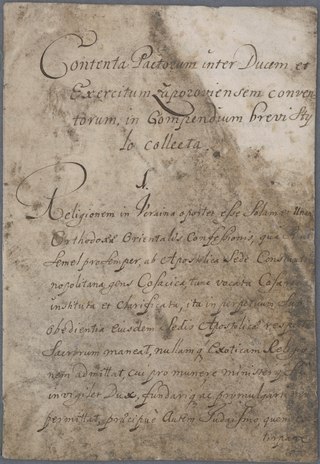
The Constitution of Pylyp Orlyk, formally titled as The Treaties and Resolutions of the Rights and Freedoms of the Zaporozhian Army, is a constitutional document written by the Hetman of the Zaporizhian Host, Pylyp Orlyk, the Cossack elders and the Cossacks of the Zaporozhian Army on the 5 April 1710 in the city of Bender (Tighina) in the Principality of Moldavia. It is sometimes called the first constitution of Ukraine.

Cossack Rada or General Military Council was a general Cossack assembly (council) often military in nature.
Various factions fought over Ukrainian territory after the collapse of the Russian Empire following the Russian Revolution of 1917 and after the First World War ended in 1918, resulting in the collapse of Austria-Hungary, which had ruled Ukrainian Galicia. The crumbling of the empires had a great effect on the Ukrainian nationalist movement, and in a short period of four years a number of Ukrainian governments sprang up. This period was characterized by optimism and by nation-building, as well as by chaos and civil war. Matters stabilized somewhat in 1921 with the territory of modern-day Ukraine divided between Soviet Ukraine and Poland, and with small ethnic-Ukrainian regions belonging to Czechoslovakia and to Romania.

The Ukrainian People's Army, also known as the Ukrainian National Army (UNA) or by the derogatory term Petliurivtsi, was the army of the Ukrainian People's Republic (1917–1921). They were often quickly reorganized units of the former Imperial Russian Army and newly formed volunteer detachments that later joined the national armed forces. The army lacked a certain degree of uniformity, adequate leadership to keep discipline and morale. Unlike the Ukrainian Galician Army, the Ukrainian People's Army did not manage to evolve a solid organizational structure, and consisted mostly of volunteer units, not regulars.
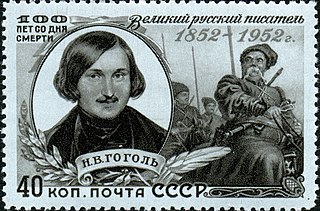
Taras Bulba is an opera in four acts by the Ukrainian composer Mykola Lysenko. The libretto was written for Lysenko by his cousin, the playwright Mykhailo Starytsky, and is based on the novella Taras Bulba, written by the Russian novelist Nikolai Gogol, himself of Ukrainian origin. The story is about a Cossack who discovers his son has betrayed his people, and kills him.
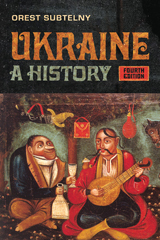
Ukraine: A History is a 1988 book on the history of Ukraine written by Orest Subtelny, a professor of history and political science at York University, Toronto, Ontario, Canada. It is a comprehensive survey of the history of the geographical area encompassed by what is modern-day Ukraine. Updated editions have been published in 1994 to include new material on the dissolution of the Soviet Union, 2000 to include Ukraine's first decade of independence, and 2009 to include the Orange Revolution and the effects of globalization on Ukraine.

The Ukrainian People's Republic (UPR) was a short-lived state in Eastern Europe. Prior to its proclamation, the Central Council of Ukraine was elected in March 1917 as a result of the February Revolution, and in June, it declared Ukrainian autonomy within Russia. Its autonomy was later recognized by the Russian Provisional Government. Following the October Revolution, the Central Council of Ukraine denounced the Bolshevik seizure of power and proclaimed the Ukrainian People's Republic with a territory including the area of approximately eight Russian imperial governorates. It formally declared its independence from Russia on 22 January 1918.
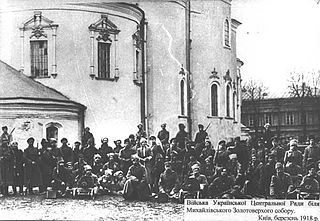
The Ukrainian–Soviet War is the term commonly used in post-Soviet Ukraine for the events taking place between 1917 and 1921, nowadays regarded essentially as a war between the Ukrainian People's Republic and the Bolsheviks. The war ensued soon after the October Revolution when Lenin dispatched Antonov's expeditionary group to Ukraine and Southern Russia.
Regiment or the Regimental system is a historical administrative, territorial, military and judicial unit of the country's subdivision of the Cossack Hetmanate and the Sloboda Ukraine in the XVII–XVIII centuries.

![Last Rada on Sich, Viktor Kovaliov [uk], the mid 19th century Viktor Kovalyov (mid-19th century) Last Rada on Sich.jpg](http://upload.wikimedia.org/wikipedia/commons/thumb/0/06/Viktor_Kovalyov_%28mid-19th_century%29_Last_Rada_on_Sich.jpg/270px-Viktor_Kovalyov_%28mid-19th_century%29_Last_Rada_on_Sich.jpg)














